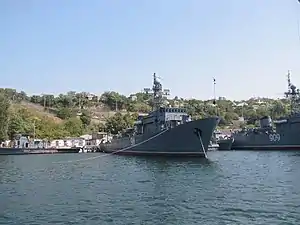 Russian ocean minesweeper project 266M "Akvamarin" Ivan Golubets in Sevastopol, 2005 | |
| Class overview | |
|---|---|
| Name | Natya class (Project 266M) |
| Builders | KB Baltic Zavod |
| Operators | |
| Preceded by | Yurka class |
| Succeeded by | Gorya class |
| Subclasses | Pondicherry class |
| Built | 1970s–2001 |
| In commission | 1970–present |
| Completed | 45 |
| General characteristics | |
| Type | Minesweeper |
| Displacement | 873 tons |
| Length | 61 metres (200 ft 2 in) |
| Beam | 10.2 metres (33 ft 6 in) |
| Draught | 3.6 metres (11 ft 10 in) |
| Propulsion | 2 × M-503 Diesel engines 5,000 hp (3,700 kW) |
| Speed | 17 knots (31 km/h; 20 mph) |
| Range | 1,500 nmi (2,800 km; 1,700 mi) at 12 knots (22 km/h; 14 mph) |
| Endurance | 7 days |
| Crew | 68 (6 officers) |
| Sensors and processing systems |
|
| Electronic warfare & decoys |
|
| Armament |
|
The Natya class, Soviet designation Project 266M Akvamarin, were a group of minesweepers built for the Soviet Navy and export customers during the 1970s and 1980s. The ships were used for ocean minesweeping.
Design
The design evolved from the Yurka-class minesweeper with new demining equipment including more advanced sonar and closed circuit TV. A stern ramp made recovering sweeps easier. The hull was built of low magnetic steel. The engines were mounted on sound dampening beams and shrouded propellers were used to reduce noise. An electrical field compensator was also installed. A single ship designated Natya 2 by NATO was built with an aluminium hull for reduced magnetic signature.
Project 02668
- Displacement: 852 tons.
- Armament: 1 × 30mm AK-306 CIWS, 2 × 14.5 mm MTPU-1 machine guns, BKT high-speed pin sweep, TEM-4 electromagnetic sweep, AT-3 acoustic sweep, SZ-1 or SZ-2 depth charges, "Livadia" mine detector-finder.
- Crew: 60.
Project 02668 was designed by Design Bureau "Almaz" and is a prototype, which demonstrates the latest technology - the logical continuation of a series of Project 266ME. The minesweeper is equipped with the most modern means of anti-mine protection. It was the first Russian mine-sweeping ship to have an integrated navigation bridge and main command center, as well as the "Diez-E" automated control system of anti-mine action activities.
The St. Andrew's flag-raising ceremony was held on 17 January 2009, and the ship was accepted into the Russian Black Sea Fleet.[1]
Operators
45 ships were built for the Soviet Navy from 1970 to 1982.
- 7 ships believed to remain in service.
- Black Sea Fleet - 3 ships
- Pacific Fleet - 2 ships
- Northern Fleet - 2 ships
- 2 captured by Russia.
- U310 Chernihiv (ex-Zenitchik - captured)
- U311 Cherkasy (captured)[2]
- 12 ships built for the Indian Navy in two batches between 1978 and 1988. Ship design was modified to Indian specifications. Known as the Pondicherry-class minesweeper in Indian service. All have since been decommissioned. These ships were to be replaced by Future Indian minehunter class, but the project is currently on hold.
- 8 ships transferred 1981-86. 2 still in active
- 2 ships captured in February 2011.
- One ship in 1986.
- One ship.
See also
Citations
- ↑ "Морской тральщик "Вице-адмирал Захарьин"" [Sea minesweeper "Vice-Admiral Zakharyin"]. Black Sea Fleet Information Resource (in Russian).
- ↑ "Russia seizes Ukraine's last Crimean ship". Reuters. 2014-03-26. Retrieved 2023-05-09.
References
- Gardiner, Robert, ed. (1995). Conway's All the World's Fighting Ships 1947–1995. London: Conway Maritime. ISBN 0-85177-605-1. OCLC 34284130. Also published as Gardiner, Robert; Chumbley, Stephen; Budzbon, Przemysław (1995). Conway's All the World's Fighting Ships 1947–1995. Annapolis, Maryland: Naval Institute Press. ISBN 1-55750-132-7. OCLC 34267261.
- "Seagoing Minesweeper Turbinist Project 266M / Natya Class". Black Sea Fleet Information Resource.
- "Seagoing minesweepers Project 266M". Russianships.info.